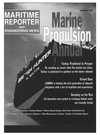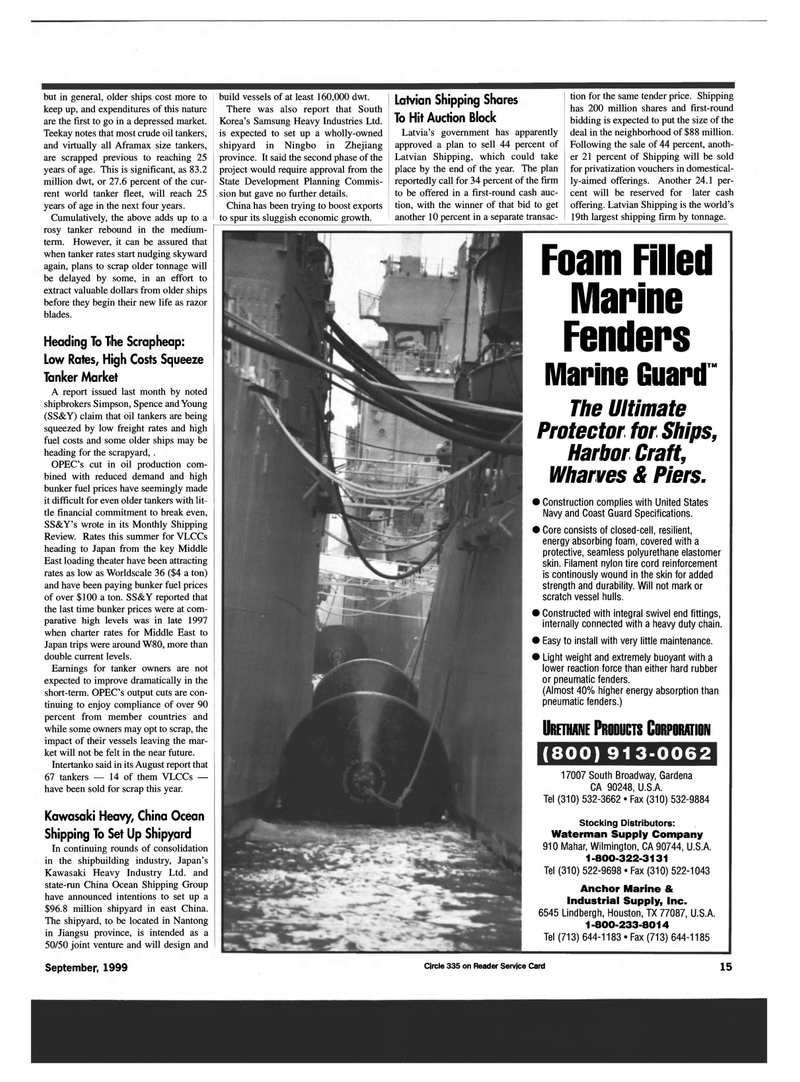
Page 15: of Maritime Reporter Magazine (September 1999)
Read this page in Pdf, Flash or Html5 edition of September 1999 Maritime Reporter Magazine
but in general, older ships cost more to keep up, and expenditures of this nature are the first to go in a depressed market.
Teekay notes that most crude oil tankers, and virtually all Aframax size tankers, are scrapped previous to reaching 25 years of age. This is significant, as 83.2 million dwt, or 27.6 percent of the cur- rent world tanker fleet, will reach 25 years of age in the next four years.
Cumulatively, the above adds up to a rosy tanker rebound in the medium- term. However, it can be assured that when tanker rates start nudging skyward again, plans to scrap older tonnage will be delayed by some, in an effort to extract valuable dollars from older ships before they begin their new life as razor blades.
Heading To The Scrapheap:
Low Rates, High Costs Squeeze
Tanker Market
A report issued last month by noted shipbrokers Simpson, Spence and Young (SS&Y) claim that oil tankers are being squeezed by low freight rates and high fuel costs and some older ships may be heading for the scrapyard, .
OPEC's cut in oil production com- bined with reduced demand and high bunker fuel prices have seemingly made it difficult for even older tankers with lit- tle financial commitment to break even,
SS&Y's wrote in its Monthly Shipping
Review. Rates this summer for VLCCs heading to Japan from the key Middle
East loading theater have been attracting rates as low as Worldscale 36 ($4 a ton) and have been paying bunker fuel prices of over $100 a ton. SS&Y reported that the last time bunker prices were at com- parative high levels was in late 1997 when charter rates for Middle East to
Japan trips were around W80, more than double current levels.
Earnings for tanker owners are not expected to improve dramatically in the short-term. OPEC's output cuts are con- tinuing to enjoy compliance of over 90 percent from member countries and while some owners may opt to scrap, the impact of their vessels leaving the mar- ket will not be felt in the near future.
Intertanko said in its August report that 67 tankers — 14 of them VLCCs — have been sold for scrap this year.
Kawasaki Heavy, China Ocean
Shipping To Set Up Shipyard
In continuing rounds of consolidation in the shipbuilding industry, Japan's
Kawasaki Heavy Industry Ltd. and state-run China Ocean Shipping Group have announced intentions to set up a $96.8 million shipyard in east China.
The shipyard, to be located in Nantong in Jiangsu province, is intended as a 50/50 joint venture and will design and build vessels of at least 160,000 dwt.
There was also report that South
Korea's Samsung Heavy Industries Ltd. is expected to set up a wholly-owned shipyard in Ningbo in Zhejiang province. It said the second phase of the project would require approval from the
State Development Planning Commis- sion but gave no further details.
China has been trying to boost exports to spur its sluggish economic growth.
Latvian Shipping Shares
To Hit Auction Block
Latvia's government has apparently approved a plan to sell 44 percent of
Latvian Shipping, which could take place by the end of the year. The plan reportedly call for 34 percent of the firm to be offered in a first-round cash auc- tion, with the winner of that bid to get another 10 percent in a separate transac- tion for the same tender price. Shipping has 200 million shares and first-round bidding is expected to put the size of the deal in the neighborhood of $88 million.
Following the sale of 44 percent, anoth- er 21 percent of Shipping will be sold for privatization vouchers in domestical- ly-aimed offerings. Another 24.1 per- cent will be reserved for later cash offering. Latvian Shipping is the world's 19th largest shipping firm by tonnage.
Foam Filled
Marine
Fenders
Marine Guard "
The Ultimate
Protector for Ships,
Harbor Craft,
Wharves & Piers. • Construction complies with United States
Navy and Coast Guard Specifications. • Core consists of closed-cell, resilient, energy absorbing foam, covered with a protective, seamless polyurethane elastomer skin. Filament nylon tire cord reinforcement is continously wound in the skin for added strength and durability. Will not mark or scratch vessel hulls. • Constructed with integral swivel end fittings, internally connected with a heavy duty chain. • Easy to install with very little maintenance. • Light weight and extremely buoyant with a lower reaction force than either hard rubber or pneumatic fenders. (Almost 40% higher energy absorption than pneumatic fenders.)
URETHANE PRODUCTS CORPORATION (800) 913-0062 17007 South Broadway, Gardena
CA 90248, U.S.A.
Tel (310) 532-3662 • Fax (310) 532-9884
Stocking Distributors:
Waterman Supply Company 910 Mahar, Wilmington, CA 90744, U.S.A. 1-800-322-3131
Tel (310) 522-9698 • Fax (310) 522-1043
Anchor Marine &
Industrial Supply, Inc. 6545 Lindbergh, Houston, TX 77087, U.S.A. 1-800-233-8014
Tel (713) 644-1183 • Fax (713) 644-1185
September, 1999 Circle 335 on Reader Service Card 15

 14
14

 16
16
